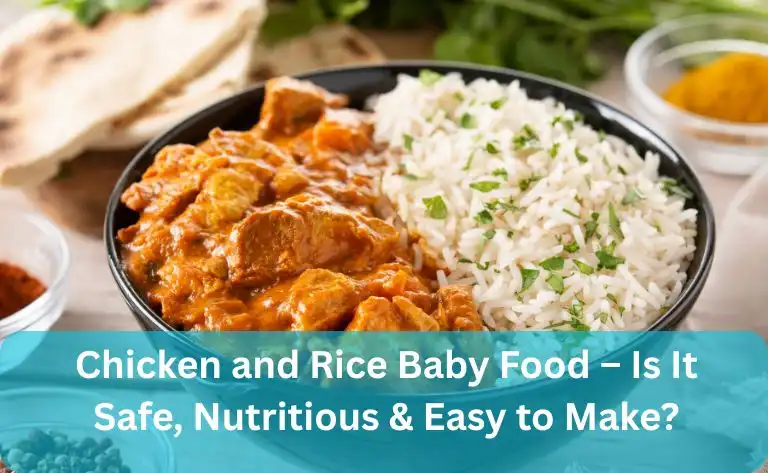As babies grow, their nutritional needs increase — and adding protein-rich foods like chicken and easily digestible carbohydrates like rice becomes essential. But how do you safely prepare and serve chicken and rice baby food? When is the right time to introduce it?
This complete 2025 guide answers all your questions with practical feeding tips, health benefits, and baby-friendly recipes — so you can nourish your little one confidently.
Read-Pineapple Baby Food: Health Benefits, Feeding Tips & Safety 2025
Also Read
When Can Babies Eat Chicken and Rice?
You can introduce both chicken and rice starting at around 6–8 months of age, depending on your baby’s readiness. By this time, babies can begin digesting simple proteins and grains.
Ideal Age:
| Food Item | Recommended Age |
|---|---|
| Chicken | 7–8 months |
| Rice | 6 months |
✅ Always start with pureed versions to minimize choking risks and support easy digestion.
Nutritional Benefits of Chicken and Rice for Babies
Both chicken and rice offer essential nutrients to support healthy growth, brain development, and immunity.
Chicken – Packed with:
-
High-quality protein for tissue and muscle development
-
Vitamin B6 and B12 for brain health
-
Iron and zinc to build a strong immune system
-
Niacin for energy metabolism
Rice – Offers:
-
Easily digestible carbohydrates for energy
-
Iron-fortified (especially in baby cereals)
-
Low-allergy risk, making it baby-safe
-
Natural fiber, helping bowel movement
As per HealthyChildren.org, protein sources like chicken can safely be added to baby meals from around 7–8 months.
How to Introduce Chicken and Rice Safely
Introducing two new ingredients together can be tricky. Here’s a smart way to do it:
Step-by-Step Feeding Plan:
-
Introduce rice first — as it’s low-allergen and easy to digest
-
After 3–5 days with no reaction, introduce pureed chicken
-
Once both are tolerated separately, mix into a smooth puree
-
Start with 1–2 tablespoons once per day
-
Gradually increase serving size with age and chewing ability
Simple Homemade Chicken and Rice Baby Food Recipe
Here’s a basic and nutritious recipe that’s easy to prepare.
Ingredients:
-
1 boneless, skinless chicken breast
-
1/4 cup white or brown rice
-
1.5 cups water
-
Optional: breast milk or formula (for thinning)
Directions:
-
Boil rice in water until fully soft
-
Cook chicken separately until fully done (no pink)
-
Blend chicken and rice together into a smooth puree
-
Add water or milk to adjust texture
-
Cool and serve lukewarm
✅ Suitable for babies 7+ months. Store unused portions in airtight containers (see storage tips below).
Baby-Friendly Chicken and Rice Variations
To add flavor and nutrition, here are safe combo ideas:
-
Chicken + Rice + Carrot Puree – Adds Vitamin A and mild sweetness
-
Chicken + Rice + Spinach – Iron-rich, green and earthy flavor
-
Chicken + Rice + Pumpkin – Creamy and full of fiber
-
Chicken + Rice + Apple – A little sweet twist to protein
Avoid adding salt, sugar, spices, or honey under 12 months.
️ Safety Tips for Chicken and Rice Baby Food
Safety is crucial when introducing meat to a baby’s diet.
Essential Tips:
-
Always cook chicken thoroughly (internal temp: 165°F / 74°C)
-
Choose organic, hormone-free chicken if possible
-
Avoid processed chicken or canned options
-
Never add salt or bouillon cubes (too much sodium)
-
Use soft, small grains of rice to prevent gagging
-
Ensure food is blended well for younger babies
If your baby experiences gas, rash, or vomiting, pause and consult a pediatrician.
❄️ Storage & Reheating Tips
Store chicken and rice baby food like any other homemade meal.
| Storage Method | Duration | Notes |
|---|---|---|
| Fridge | 48 hours | Use airtight container |
| Freezer | 1–2 months | Portion in ice cube trays |
| Reheating | Use a baby food warmer or warm water bath | Avoid microwave hot spots |
⚠️ Do not refreeze once thawed.
Sample Feeding Schedule with Chicken & Rice
| Time | Meal Idea |
|---|---|
| Morning | Breastmilk + rice cereal |
| Lunch | Chicken + rice + veggie puree |
| Snack | Banana or avocado mash |
| Dinner | Chicken + rice + pumpkin blend |
Rotate meals with other proteins like lentils, tofu, or fish (if baby is ready) to build balanced nutrition.
❓ Frequently Asked Questions
1. Can I give chicken to a 6-month-old?
Chicken can be introduced around 7 months. Start with rice or veggies first.
2. Should I blend chicken and rice?
Yes. For babies under 9 months, a smooth puree is best.
3. Can I use store-bought chicken baby food?
You can, but check for preservatives, sodium, and sugar. Homemade is usually fresher and healthier.
4. Is brown rice or white rice better for babies?
Both are okay. Brown rice has more fiber, but white rice is easier to digest.
5. Can chicken cause allergies in babies?
Rarely. Chicken is a low-risk allergen, but always watch for any signs of intolerance.
✅ Conclusion
Chicken and rice baby food is a nutritious, wholesome choice for babies entering the world of solid foods. With its combination of essential proteins, carbs, and vitamins, it supports healthy growth, immune development, and digestive wellness.
Start with simple purees, follow safe preparation methods, and introduce new combinations gradually. By feeding your baby smartly and safely, you’re laying the foundation for a healthy food relationship that lasts a lifetime.
Trusted Source-HealthyChildren.org





